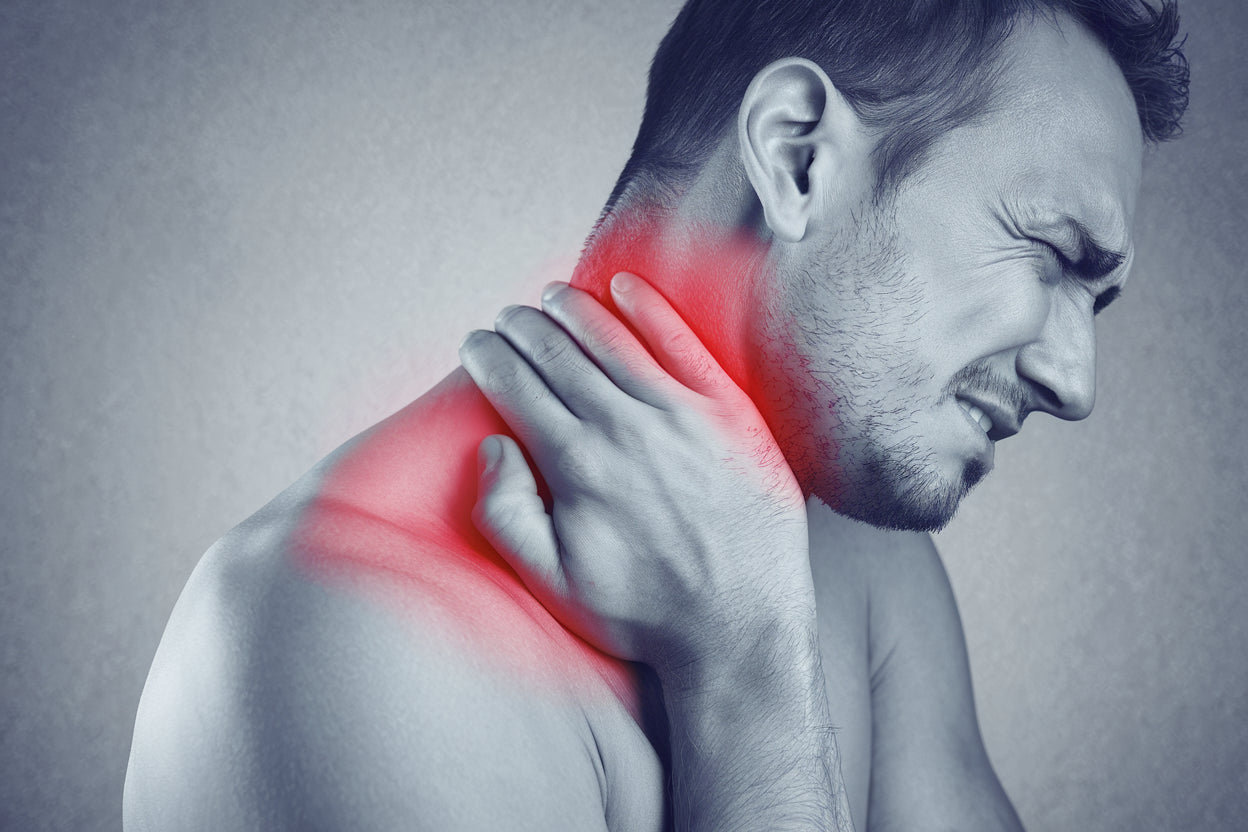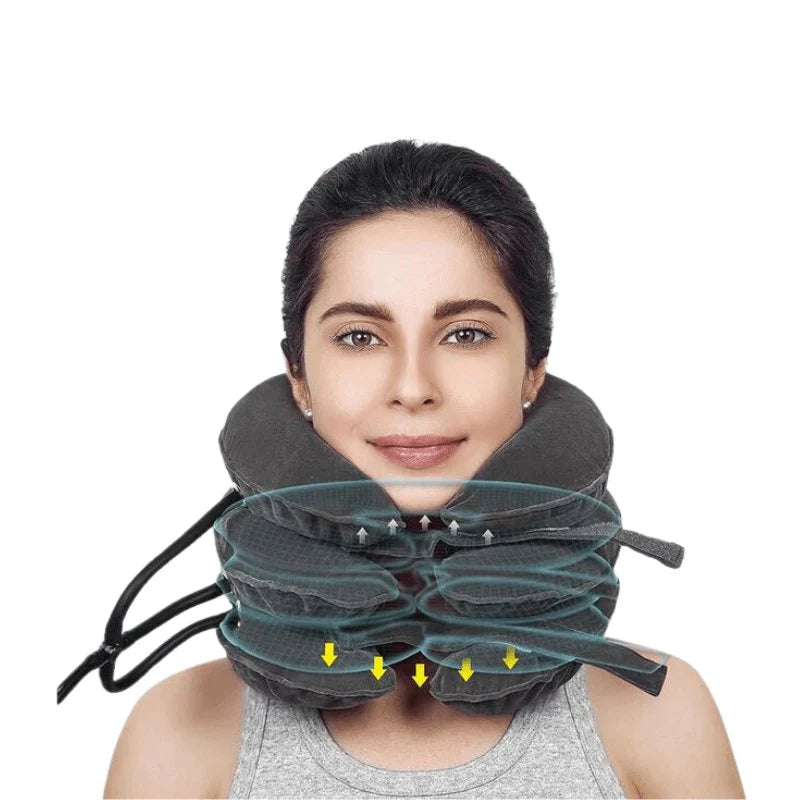Nerve Pain in the Neck: Symptoms, Causes, and Treatment

Neck pain, also known as cervical radiculopathy, is a condition in which a nerve in the neck becomes irritated or pinched. This can cause pain and other symptoms that radiate from the neck. Neck pain is characterized by a burning or tingling sensation that is often aggravated by movement and can significantly affect quality of life.
What is nerve pain in the neck?
Nerve pain in the neck occurs when a nerve becomes irritated or pinched, often due to a herniated disc or poor posture. It can cause radiating pain, numbness, and tingling. Early treatment with rest, physical therapy, and medication can relieve the symptoms. Read more about herniated discs in the neck .
Symptoms of nerve pain in the neck
Common symptoms include:
- Radiating pain from the neck down the arm
- Numbness and tingling in the arm and hand
- Muscle weakness in the arm
- Impaired sensation in parts of the arm or hand
- Neck pain that worsens with certain movements
- Headache, especially in the back of the head
Nerve pain in the arm, neck, and shoulder blade is common with this condition. Symptoms can vary from person to person, but the radiating nature of the pain is a typical sign that the nerves are affected. Neuropathic pain in the neck can be experienced as sharp, burning, or like an electric shock through the affected areas. Many patients describe that symptoms worsen with certain positions or activities, and that the pain can disrupt sleep at night.
When touching the affected areas, the patient may experience increased sensitivity or pain. In most cases, symptoms develop gradually, but they can also appear suddenly after a specific event or movement.
Causes of nerve pain in the neck
Several factors can contribute to nerve pain in the neck:
- Whiplash injury
- Overexertion or incorrect posture
- Age-related changes in the spine
- Narrowing of nerve channels (spinal stenosis)
- Trauma or sudden movements
Neck pain with nerve involvement is often caused by a nerve root being pinched or irritated where it exits the spinal cord through the neck. Cervical disc herniation is one of the most common causes, where one of the discs between the vertebrae in the neck bulges out and presses on nearby nerves.
Degenerative changes such as cervical spondylosis can also cause nerve pain as the vertebrae and ligaments thicken over time, reducing the space for the nerves. Sudden trauma such as whiplash can also damage the peripheral nerves or cause inflammation that affects nerve function.
Prolonged poor posture, especially when working at a computer, can contribute to nerve compression by increasing the strain on the structures of the neck. Regardless of the various causes of nerve pain in the neck, this condition should be investigated by a healthcare professional to determine the exact mechanism and appropriate treatment.
Diagnosis and treatment of nerve pain in the neck
Nerve pain in the neck often occurs when a nerve in the cervical spine becomes irritated or pinched. This can lead to radiating pain, numbness, or weakness in the shoulders, arms, or hands. An accurate diagnosis is crucial to identifying the cause and choosing the right treatment.
Diagnosis is usually made through a physical examination and neurological tests to assess reflexes, sensation, and mobility. If necessary, X-rays or MRIs are also used to map the discs, nerves, and structure of the spine.
Physiotherapy
Through exercises and stretching, muscle tension can be relieved and blood circulation improved.
Neck Comfort™ provides stability and support during exercise, helping to reduce strain on the neck.
Pain relief
If necessary, anti-inflammatory medications can be used to reduce pain and swelling.
With the support of Neck Comfort™, the need for medication can be reduced thanks to improved posture and relief.
Heat and cold therapy
Alternating between heat and cold can relieve pain, reduce inflammation, and promote healing.
Termoreliever™ offers both heating and cooling functions for flexible pain relief at home.
Nerve mobilization
Nerve mobilization is a physiotherapeutic technique that improves nerve mobility and reduces the risk of compression.
NackKomforten™ can be used in parallel to provide support during rehabilitation and reduce relapse.
Important to consider
Chronic nerve pain in the neck may require a combination of treatments – such as physiotherapy, painkillers and, in some cases, injections. Early treatment can prevent the condition from getting worse and significantly improve quality of life.

How Neck Comfort™ and Termoreliever™ can help with nerve pain in the neck
Neck Comfort™ and Termoreliever™ offer several benefits for people with nerve pain in the neck:
- Neck Comfort™ provides support and improves posture
- Termoreliever™ offers both heat and cold therapy for pain relief
- The combination can help reduce pressure on the nerves
- The products can be used during daily activities for continuous support
- Contributes to faster recovery and reduced risk of relapse
For patients with nerve pain in the neck, these products can be valuable tools in the daily management of symptoms. NeckComfort™ helps stabilize the neck and reduce strain on the damaged nerves, which can relieve pain and improve mobility. The improved posture the support provides can also reduce pressure on the nerve roots where they exit the spine.
Termoreliever™ can be used to manage the inflammation that often contributes to nerve pain. Cold therapy reduces swelling and inflammation around the damaged nerves, while heat therapy increases blood circulation, which can speed healing and reduce stiffness in the neck muscles.
Buy nowConclusion
Neck pain can be a painful and debilitating condition, but with proper diagnosis and treatment, most people can experience significant improvements. By combining conservative treatment methods such as physical therapy and the use of supportive devices such as Neck Comfort™ and Termoreliever™, many people can effectively manage their symptoms and improve neck function. It is important to consult a doctor for a proper diagnosis and individualized treatment plan.
For people suffering from cervical nerve pain, it is crucial to understand that treatment often requires patience and a multidisciplinary approach. By identifying and addressing the underlying causes, followed by appropriate treatment and support, most patients can regain mobility and significantly reduce pain.
Frequently Asked Questions (FAQ)
How long does nerve pain in the neck usually last?
With the right treatment, many people can experience improvement within 4-6 weeks, but this can vary depending on the cause and severity.
Can I exercise with nerve pain in my neck?
Light exercise and specific exercises are often recommended as part of treatment. Consult a physical therapist for a customized program.
How do I use Termoreliever™ for nerve pain in the neck?
Use cold therapy initially to reduce inflammation, followed by heat therapy to increase blood circulation and reduce stiffness.
Can Neck Comfort™ prevent nerve pain in the neck?
Yes, by providing support and improving posture, Neck Comfort™ can help reduce the risk of nerve compression and related pain.
When should I seek emergency medical attention for nerve pain in my neck?
Seek immediate medical attention if you experience sudden, severe pain, loss of feeling or strength in your arm, or if you have difficulty controlling your bladder or bowels.

